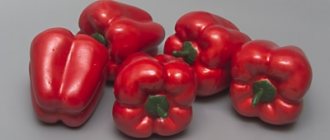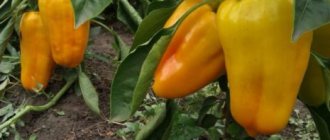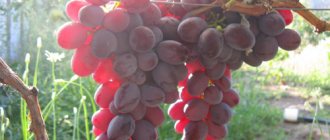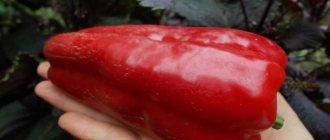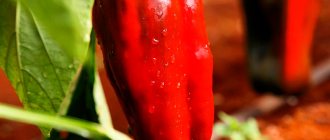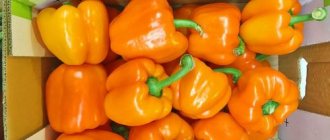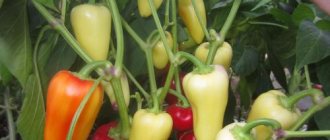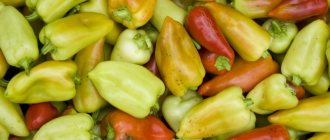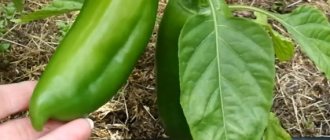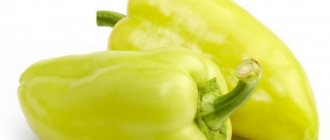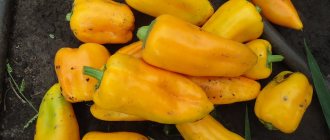Vegetable growing » Pepper
0
1315
Article rating
Kira Stoletova
Ruby pepper is a variety of bell pepper that is popular among gardeners. A detailed description of the variety is presented in the article.
Salad pepper Ruby variety
Characteristics of the variety
Ruby pepper originated in Moldova. This hybrid is the result of crossing two varieties: Gift of Moldova and Novy Goshary. A distinctive feature of the resulting hybrid is its unpretentiousness and cold resistance.
Refers to standard plants. Despite its powerful foliage, the crop is quite compact. Ruby pepper reaches a height of 45 to 60 cm.
The Ruby hybrid is classified as a mid-season variety. Technical maturity of the fruit occurs 130–150 days from the appearance of full shoots.
Fruit
The rather large fruits of Ruby pepper have a flattened shape. Weight varies from 110 to 160 grams. The fruits are distinguished by juicy and fleshy walls, the thickness of which ranges from 7 to 10 mm. Some specimens boast a wall thickness of 1 cm. The color of the fruit depends on the degree of ripeness. Ideally ripe paprika is dark red in color.
The hybrid is characterized by high productivity. With proper agricultural technology and timely care, gardeners harvest up to 5 kg of fruit from each square meter.
Paprika of this variety has excellent taste. The fruits can be used already at the stage of technical ripeness. This vegetable is perfect for fresh summer salads, any kind of heat treatment, canning, and pickling.
How to make an order
You can purchase the necessary seeds on the website by filling out the application form. To do this, send the required product unit, or several, to the “Basket”, and there, enter your data without abbreviations in the appropriate fields, being sure to specify the desired quantity of products.
By clicking on the “Complete” button, you confirm your intention to purchase, and to your email. You will receive an email notification that your application has been accepted, and then that a shipment has been generated with a card number for payment.
The Royal Garden web resource presents only high quality seeds and the best varieties of crops, as evidenced by customer reviews.
Planting a variety
To obtain good yields, crops are recommended to be grown in seedlings. Start sowing seeds in the second half of February. For regions with a fairly harsh climate, gardeners recommend sowing the hybrid for seedlings in mid-March.
Germination of seeds
Vegetable growers advise germinating the seeds before planting peppers. Take seed material that is two or three years old. Fresh seeds will grow into a plant that does not have the distinctive characteristics of the mother plant.
Choosing seeds
When germinating seeds, follow the instructions:
- Treat the selected seed material with a pink solution. The concentration of manganese should not exceed 1%. Keep the seeds in this solution for 10-15 minutes, stir the contents several times during this time. Floating seeds are unsuitable for planting.
- Catch the seeds that have sunk to the bottom. Dry them.
- Line the bottom of the prepared container with gauze or cloth. Place the prepared seed material on it.
- Pour enough liquid to wet the fabric thoroughly, but the seeds should not float. For these purposes, use water or ash solution. The water must be pre-settled and at room temperature. Prepare an ash solution from one liter of water and one tablespoon of ash.
- Cover the container with cling film. During this period, create a favorable temperature regime for the seeds. The comfort zone is from 25 to 300C.
Advantages and disadvantages
Pepper Rubik F1 has an extensive list of worthy characteristics:
- The hybrid withstands low air temperatures both at the seedling stage and during fruiting.
- The plant is immune to several destructive diseases.
- For consumers, the vegetable is universal.
- The culture can develop when the beds are shaded.
- Pepper is not prone to deformation during transportation.
- The fruits have good shelf life.
- The plant's productivity exceeds 7 kg/m2.
- The bushes are not spreading, so it is rational to plant them in a greenhouse or open ground.
The hybrid has 2 main disadvantages:
- own seeds do not provide a high-quality harvest;
- pepper can break without a garter.
Sowing seeds
After the seeds hatch, start sowing them. Fill the containers 1/3 full with fertilized soil mixture. Do not plant seeds deeper than 5 mm. Sprinkle the seeds with a mixture of sand and soil. For every part of sand, take one part of soil. This will give lightness to the soil. It will be easier for sprouts to break through such a layer of soil.
Cover the containers with cling film and leave, maintaining the temperature at least 25 C. As soon as the first shoots appear, remove the film.
First shoots
For normal development, vegetable seedlings need twelve hours of daylight. In winter, there is not enough natural light. Solve the problem of lack of light by installing additional lamps. Remember to let the plant rest at night.
Maintain the temperature during the day at 20 - 25C. At night, the thermometer should not fall below 18C.
Top dressing
Hybrid sprouts require feeding. Carry it out after the first two true leaves appear. Dissolve a mixture of 10 g of urea, 40 g of superphosphate and 10 g of potassium salt in 10 liters of water. Water the seedlings with the resulting solution.
The culture will gratefully accept foliar feeding. To do this, make a solution based on a growth stimulator and spray the plants. Carry out this procedure on cloudy days. After this, do not place the seedlings on the windowsill for one or two days.
Hardening of seedlings
Two weeks before planting the sprouts in a permanent place, begin to harden the plant. In the first days, take the plant outside for one to two hours. Gradually increase the time the seedlings spend in the fresh air until daylight hours. Immediately before transplanting, leave the plants outside for a day.
When hardening off paprika seedlings, make sure that the plant is not in drafts or exposed to too sudden temperature changes.
Reproduction methods and agricultural technology
Typically, raspberry bushes of this variety produce up to seven new shoots per year. To propagate it, gardeners resort to the following procedure:
At the beginning of spring or autumn, the central part of the raspberry bush is cut out. The diameter of this part can be in the range from 10 to 20 cm.
Important! Cut the bush carefully and carefully so as not to damage the rest of the plant. Then the raspberry bushes are provided with good and competent care. If the requirements of agricultural technology are met, then next year the roots will produce at least 20 new shoots, which will serve as material for propagation
If the requirements of agricultural technology are met, then next year the roots will produce at least 20 new shoots, which will serve as material for propagation
Then the raspberry bushes are provided with good and competent care. If the requirements of agricultural technology are met, then next year the roots will produce at least 20 new shoots, which will serve as material for propagation.
The second option that gardeners use is propagation of raspberries by green cuttings. They are harvested in May from annual shoots
It is important to choose green ones and those that are located 3-5 cm high above the ground. They contain a sufficient supply of nutritional components and good growth qualities
Cuttings are not prepared at once. Depending on the awakening of the kidneys, this process lasts from May to June. The shoot is cut off when the rosette is formed, but when the growth of the shoot has not yet begun.
Advice! It is better not to cut off shoots with a high aerial part.
They have entered the stage of intensive growth and will take root less well. Suitable shoots are cut at a shallow depth and removed along with the soil. Immediately transplant into a cuttings with moist and oxygenated soil. After two weeks, new roots begin to grow, but it is too early to replant the cuttings. They are moved to a new place no earlier than in a month.
Many remontant raspberry varieties are propagated in this way.
Bush care
Ruby sweet pepper is suitable for growing both in open ground and in greenhouses. The seedlings are transferred to the beds at the age of 25–30 days. For proper plant development and large yields, create favorable growth conditions for the hybrid.
- The culture does not like frequent watering. The plant only needs one or two heavy waterings per week. Use settled and warm water.
- Don’t forget to loosen and weed the beds with peppers. This will create lightness in the soil, saturate it with oxygen, and get rid of weeds.
- Apply fertilizers in a timely manner. Apply the first fertilizing 10–14 days after planting the seedlings. Use organic fertilizers. Make the next addition of nutrients during the flowering period of the crop. After three weeks, feed the hybrid with mineral fertilizers.
- Treat the plant with insecticides to prevent infestations of small insects.
- The culture is resistant to many diseases, including Verticillium wilt. Don't neglect preventive measures. Spray the crop with fungicides.
Sad pepper of the Ruby variety is perfect for growing in your garden. Proper care and adherence to agricultural practices will allow you to enjoy pepper fruits that exude an incredible aroma.
Sweet pepper 'Ruby'
Main genus: Bell pepper
| Size |
| Productivity |
| Ripening period |
| Soil type |
| Growing method |
| Purpose of fruits |
| Disease resistance |
| Soil ph requirements |
| Life form |
| Shape of fruits/stems/roots and tubers/heads |
| Size of fruits/stems/roots and tubers/heads |
| Cultivation region by origin |
| Vitamin content |
| Color of fruits/roots and tubers |
| Leaf/stem/head color |
| Fruit/root and tuber pulp color |
| Peel thickness |
| Frost resistance |
| Drought resistance |
| Decorative value |
| Taste of fruits |
| Shelter for the winter |
| Pest resistance |
| Habit |
| Keeping quality |
| Parthenocarpic |
| Branching pattern |
| Density and character of the pulp |
Expand all properties
Description of the plant:
Sweet pepper 'Ruby' is a variety obtained at the Transnistrian Research Institute of Agriculture. Approved for use in the North Caucasus region in 1980.
Dimensions and growth form:
The 'Ruby' variety is represented by compact plants, 45–60 cm high. The position of the fruits on the plant is mixed.
Fruit:
Size, shape and color:
The fruits are rounded and flattened, large, with an average weight of 113–166 g. The surface is slightly ribbed. The wall thickness at biological ripeness is 7.6–10.0 mm.
The color of the fruit in technical ripeness is light green, in biological ripeness it is dark red.
Ripening time and yield:
Sweet pepper 'Ruby' is a medium-ripening variety (mid-ripening). The period from mass germination to the onset of biological ripeness of the fruit is 160–178 days. Productivity is 2.9–3.3 kg/m2.
Disease resistance:
The variety is moderately affected by bacterial wilt.
Directions for use:
Recommended for canning using fruits at biological ripeness.
